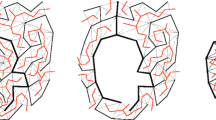Abstract
We consider the problem of preprocessing an edge-weighted directed graph to answer queries that ask for the shortest path from any given vertex to another avoiding a failed link. We present two algorithms that improve on earlier results for this problem. Our first algorithm, which is a modification of an earlier method, improves the query time to a constant while maintaining the earlier bounds for preprocessing time and space. Our second result is a new algorithm whose preprocessing time is considerably faster than earlier results and whose query time and space are worse by no more than a logarithmic factor.
This work was supported in part by Texas Advanced Research Program Grant 003658-0029-1999 and NSF Grant CCR-9988160. Chowdhury was also supported by an MCD Graduate Fellowship.
Access this chapter
Tax calculation will be finalised at checkout
Purchases are for personal use only
Preview
Unable to display preview. Download preview PDF.
Similar content being viewed by others
References
C. Demetrescu, G. F. Italiano. Fully dynamic all pairs shortest paths with real edge weights. In Proc. of the 42nd IEEE Annual Symposium on Foundations of Computer Science (FOCS’01), Las Vegas, Nevada, pp. 838–843, 2001.
C. Demetrescu, M. Thorup. Oracles for distances avoiding a link-failure. In Proc. of the 13th IEEE Annual ACM-SIAM Symposium on Discrete Algorithms (SODA’02), San Fransisco, California, pp. 838–843, 2002.
M. L. Fredman, R. E. Tarjan. Fibonacci heaps and their uses in improved network optimization algorithms. Journal of the ACM, 34:596–615, 1987.
V. King, G. Sagert. A fully dynamic algorithm for maintaining the transitive closure. In Proc. of the 31st ACM Symposium on Theory of Computing (STOC’99), pp. 492–498, 1999.
V. King, M. Thorup. A space saving trick for directed fully dynamic transitive closure and shortest path algorithms. In Proc. of the 7th Annual International computing and Combinatorics Conference (COCOON), LNCS 2108, pp. 268–277, 2001.
V. King. Fully dynamic algorithms for maintaining all-pairs shortest paths and transitive closure in digraphs. In Proc. of the 40th IEEE Annual Symposium on Foundations of Computer Science (FOCS’99), pp. 81–99, 1999.
J. Naor, M. Naor, A. A. Schaffer, “Fast parallel algorithms for chordal graphs,” SIAM J. Computing, Vol. 18, pp. 327–349, 1989.
S. Pettie, V. Ramachandran. Computing shortest paths with comparisons and additions (extended abstract). In Proc. of the 13th Annual ACM-SIAM Symposium on Discrete Algorithms (SODA), pp. 267–276, 2002.
V. Ramachandran. Parallel algorithms for reducible flow graphs. Journal of Algorithms, 23:1–31, 1997. (Preliminary version in Princeton Workshop on Algorithm, Architecture, and and Technology, S.K. Tewksbury, B.W. Dickinson, S.C. Schwartz, ed., 1987, pp. 117–138. Plenum Press.)
M. Thorup. Fortifying OSPF/IS-IS against link-failure, 2001. Manuscript.
Author information
Authors and Affiliations
Editor information
Editors and Affiliations
Rights and permissions
Copyright information
© 2002 Springer-Verlag Berlin Heidelberg
About this paper
Cite this paper
Chowdhury, R.A., Ramachandran, V. (2002). Improved Distance Oracles for Avoiding Link-Failure. In: Bose, P., Morin, P. (eds) Algorithms and Computation. ISAAC 2002. Lecture Notes in Computer Science, vol 2518. Springer, Berlin, Heidelberg. https://doi.org/10.1007/3-540-36136-7_46
Download citation
DOI: https://doi.org/10.1007/3-540-36136-7_46
Published:
Publisher Name: Springer, Berlin, Heidelberg
Print ISBN: 978-3-540-00142-3
Online ISBN: 978-3-540-36136-7
eBook Packages: Springer Book Archive




